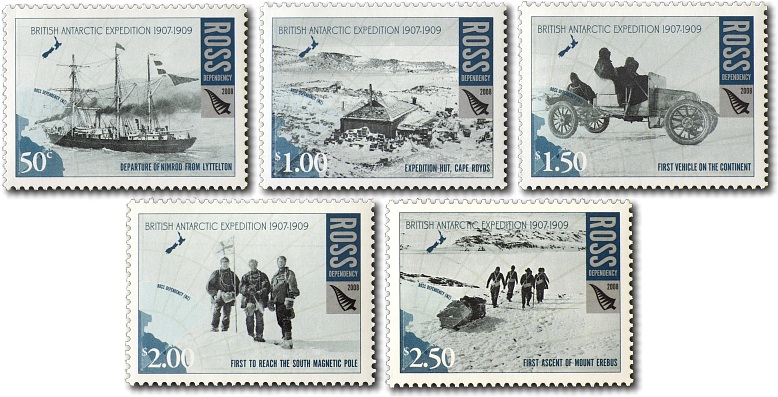
2008 Ross Dependency - 100th Anniversary of the British Antarctic Expedition
«previous next»

| Cat. | Mint Unhinged | Fine Used | ||||
| 50c | Departure of Nimrod from Lyttelton / 1 January 1908 | 663a | $0.90 | $0.85 | ||
| $1 | Pre-fabricated Expedition Base Hut / Cape Royds | 663b | $1.80 | $1.70 | ||
| $1.50 | First Vehicle on the Continent | 663c | $2.70 | $2.55 | ||
| $2 | First to reach the South Magnetic Pole / 16 January 1909 | 663d | $3.60 | $3.40 | ||
| $2.50 | First ascent of Mount Erebus / 9 March 1908 | 663e | $4.50 | $4.25 | ||
| Set of 5 | 663f | $12.85 | $12.10 | |||
| First Day Cover - 5 November 2008 | 663g | $14.40 | ||||
| … Five Stamps : 50c (663a), $1 (663b), $1.50 (663c), $2 (663d), $2.50 (663e) | ||||||
Initially, the expedition's public profile was much lower than that of Scott's Discovery Expedition six years earlier. However, nationwide interest was aroused by the news of its achievements. The South Pole was not attained, but the expedition's southern march reached the farthest south latitude of 88 degrees 23 minutes, and the expedition could claim that it had got within one hundred miles of the Pole. This was by far the longest southern polar journey to that date.
During the expedition a separate group led by Welsh Australian geology professor Edgeworth David reached the estimated location of the South Magnetic Pole, and the first ascent was made of Mount Erebus, Ross Island's active volcano. The scientific team carried out extensive geological, zoological and meteorological work. Shackleton's transport arrangements, based on Manchurian ponies, motor traction and sled dogs, were innovations which were later copied by Scott for his ill-fated Terra Nova Expedition.
The expedition was a public triumph, although in the eyes of some of the London geographical establishment its successes were compromised because Shackleton had broken a promise made under duress to Scott that he would not base his winter quarters in or near McMurdo Sound. Ice conditions had ultimately forced Nimrod to land there.
On his return, Shackleton survived the Royal Geographical Society's skepticism about his achievements and received many public honours, including a knighthood from King Edward VII. Within three years his farthest south record had been surpassed, as first Amundsen and then Scott reached the South Pole. In his own moment of triumph Amundsen recognized: "Sir Ernest Shackleton's name will always be written in the annals of Antarctic exploration in letters of fire".
Bibliography
The Postage Stamps of New Zealand Volume X
Edited by B.G. Vincent FRPSNZ
Published 2013 by The Royal Philatelic Society of New Zealand Incorporated (ISBN 978-0-9876534-3-7)
Pages 669 - 670
Catalogue ·
2007 ·
2008 ·
2009 ·
Commemoratives ·
Ross Dependency (Antarctic)
Order Form · Currency Converter · Privacy Policy
What to Expect · Contact Us · Links
Order Form · Currency Converter · Privacy Policy
What to Expect · Contact Us · Links
This page was last updated on 18 Sep 2025
All content and images copyright © 2008 - 2025 StampsNZ
All content and images copyright © 2008 - 2025 StampsNZ